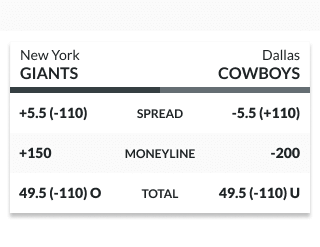How To Understand Betting Lines
Below is an automatically updating feed that lists the current odds for professional golf. If you like to bet on PGA golf, bookmark this page for quick access to the latest golf betting lines. If you are looking to bet on golf, we recommend Sports Interaction, non-USA bettors only. 18+, T&Cs apply, and Gamble Responsibly (BeGambleAware).
Sports betting guide introducing how to read odds and wager on sports. Moneyline, point spread, and over under bets are explained. Learn how to gamble! With a moneyline bet, one is simply betting who will win the game regardless of the margin of victory. The Cowboys have a moneyline of -400. This fact introduces another important sports term called the “vig.” Those who bet the “Cowboys moneyline” would need to wager $400 to return a profit of $100.
How to Read the Lines

Golf betting lines can be read in American odds, decimal odds, or fractional odds – whichever you choose. Most sportsbooks offer a button where you can change the odds into your preferred format.
American golf lines are read as negative (-) or positive (+). A negative golf line indicates a favorite, but isn’t usually seen until the third or fourth day of a tournament when one or two players take a significant lead. Before a golf tournament starts, every player will be given a positive line. Negative and positive golf lines are based around the $100 figure, but payouts are calculated differently.
A negative golf line will be listed something like this:

- Tiger Woods: -140
This means that Tiger Woods is the favorite, and that it takes a bet of $140 to win $100 more, for a total return of $240.
A positive line will look something like this:
- Phil Mickelson: +210
In this case, a bet of $100 would pay out a $210 profit, for a total return of $310. A positive golf line can be a favorite or an underdog, depending on how the other players lines are set. If Phil Mickelson at +210 are the lowest odds of any of the players, then he is still considered the favorite. This happens in the earlier rounds of a golf tournament when no players have taken a big lead.
So, to wrap this up, a negative money line indicates the amount of money needed to wager to win $100 in profit, and a positive money line indicates the amount of profit that can be won from a $100 wager.
Types of Golf Betting Lines
Wagering on golf is interesting because not only can you bet on winners of future golf events, but also after each day of a tournament. Based on how players finish each day changes the odds, giving you multiple opportunities to pick the winner. While the odds for players at the top of the leader-board go down as a tournament progresses, you can get a feel for how players are doing throughout the weekend. If a player is rising throughout the weekend, but is still 2 or 3 shots off the lead going into Sunday, you’ll get decent odds on him while he’s hot. If the top player is not a great closer, this could be a smart time to bet.
Futures Lines
Different types of futures bets can be made for PGA, LPGA, and EPGA golf. You can bet on how many majors Tiger Woods will win, or if any of the other top players will win a major as well. Most sportsbooks offer these types of futures bets on Padraig Harrington, Rory Mcilroy, Steve Stricker, Lee Westwood, Paul Casey, Geoff Ogilvy, Phil Mickelson, Anthony Kim, Jim Furyk, Jeff Overton and more.
Futures bets can also be made on the Ryder Cup, the Open Championship, the Masters, the US Open Championship, the PGA Championship and many other tournaments throughout the season.
Most newspapers and online sports betting sites publish the line on a football or basketball game simply as a single number. In our example we will use Chicago against New York in which Chicago is favored by 4 points versus New York. Some bettors refer to this as the favorite laying 4 points, and the underdog getting 4 points. The spread is typically displayed in the following format:
- Chicago -4
- New York +4
By betting the spread, a sports bettor wagers on the amount of points a team is projected to win or lose by. In the example above, -/+4 is the spread. Since the spread is 4, Chicago must win by 5 or more points to win the bet, while New York can lose by 3 or fewer points to win the bet. If Chicago wins by exactly 4, then the bet is a push and no one wins or loses money.
Often there is a number to the side of the spread, such as Chicago -4 (-110). This is to show how much extra money a bettor must risk on their wager.
The (-110) important for calculating payouts and break-even percentages. Since it is -110, we must bet 1.10 to win 1.00, so for each $1 we want to win, we have to risk $1.10. For example, a sports bettor must risk $11 to win $10, $55 to win $50, $110 to win $100, $1100 to win $1,000 and so forth. If the line is a single number, like in the first example, -110 is simply assumed As you may have noticed, bettors are risking 10% more than they can possibly win from their wager.
There’s a technical term for this extra fee: vigorish. The vigorish, also known as “vig” or “juice”, gives sportsbooks a mathematical advantage, commonly referred to as the house hedge. You have likely seen similar fees for casino games. This how sportsbooks make a profit. Since sportsbooks charge a fee, sports bettors winning only 50% of their bets will likely end up losing money in the long term. Taking into account the vigorish, you need to win not half of your bets but at least 52.4% to break even on traditionally-juiced lines (-110).
A common misconception is that, because of this fee, sportsbooks stand to make 10% from the total amount of money bet, also known as the handle. For clarity’s sake, the commission charged to sports bettors is actually 5%. Remember, there is action on each side of a betting line. Say the betting handle on New York vs. Chicago is $1100, divided evenly between the two teams. With $550 to win $500 wagered on Chicago -4 (-110) and $550 to win $500 on New York +4 (-110), the sportsbook will profit $50 off this game, or 5%, so long as Chicago does not win by exactly four points. In the case of a push, all money wagered on the spread will be returned to bettors.
While -110 is typical for spreads and totals, in the era of online sports betting, competition among legal US sportbooks often leads to better deals for customers. One no longer needs to risk an extra 10% on every wager. Some US sportsbooks will run promotions where sports bettors only have to risk an extra 5% on most games instead of 10%. In this case, the line would look like:
- Chicago -4 (-105)
- New York +4 (-105)
One would only risk $105 to win $100 a wager on Chicago winning by 5 or more points. If you win, you still win $100, but if you lose you’ll only lose $105 instead of $110. It may seem like a small difference, but that extra $5 can add up over the course of a season.

Sometimes the line will be displayed as a rather larger number to the side of the point spread. Let us look at an example where you would need to wager $120 in order to win $100:
- Chicago -4 (-120)
- New York +4 (-100)
In this case, the bookmaker is getting a lot of action on Chicago. The bookmaker has two choices. Option A) they move the spread to Chicago -4.5/New York +4.5, or B) if they like the current spread, they can stick with Chicago -4 and move the “juice” instead, hence -120.
Now bettors will risk $120 to win $100 on Chicago -4. On the other hand, those wagering on New York +4 will only risk $100 to win $100 (even money). This is how the bookmaker incentives bettors to wager on New York and balance their sportsbook’s betting handle.
You might find one sportsbook with Chicago -4 (-120) and Chicago -4 (-110) at a different sportsbook. This is why it’s so important for sports bettors to shop for the best lines across the US sports betting industry. The best way to shop lines is to use our odds comparison tools, which you can find for NFL, NBA, MLB, NCAAB, NCAAF and NHL.
How To Understand Betting Lines In Vision
In general most bookmakers apply the principle that the difference between betting on the favorite and the underdo is 20 cents. So if the favorite is -115 then the dog is -105. If the favorite is -125, then the dog is +105. And if the favorite is -110, then the dog is -110.
How To Understand Gambling Lines
The same principle applies to wagers on the point total (Over/Under) of the game. If the game total is O41 (-120), U41 (-100) then a $120 wager on the over will win $100 while $100 on the Under will win $100. If the line simply states 41, then you are risking 1.10 to win 1.0 whether your bet is on the over or the under. Again, you can minimize the difference between the over and under and favorites and underdogs by using our odds comparison tools to shop lines.
A Moneyline bet is a wager on the outcome of the game regardless of the point spread. So if you bet the moneyline, you are betting on a team to win the game straight up (or outright). Moneyline wagering is more popular for MLB, NHL, golf matchups and combat sports such as the UFC and boxing, but you can also find moneylines for football and basketball. The usual display for a moneyline wager is as follows:
- X Team/Player -200
- Y Team/Player +170
As you can see, the spread disappeared. Now the number to the side of Team/Player is the moneyline. The moneyline is fluid, fluctuating based on the matchup and the amount of money being bet on each side. In this particular example, a sports bettor must risk $200 to win $100 (2-to-1) if they’re betting on the favorite to win the game. One may bet $200 to win $100, $150 to win $75, $10 to win $5 and so forth. The bottom line is the same, one has to risk twice as much as they want to win.
A $100 wager on the underdog will net the sports bettor $170 if the underdog pulls off the outright upset. One may bet $100 to win $170, $200 to win $340, etc. The bottom line is the same, a bet on the underdog results in a +170% ROI if the underdog wins.
This principle is universal for moneylines, regardless of the team or sport. If Tiger Woods is -180 vs. Phil Mickelson +160, golf bettors must risk 1.80 to win 1.00 on Tiger. Those betting on Phil will risk 1.00 to win 1.60
If you’re new to sports betting, we hope this page helped answer some important questions. We also have a parlay calculator for your convenience, along with the odds comparison tools mentioned above. Be sure to use all of our sports betting tools and tips to help save you time and money at legal US sportsbooks.
Note: Lines and scores highlighted in blue signify an update within the last ten minutes.